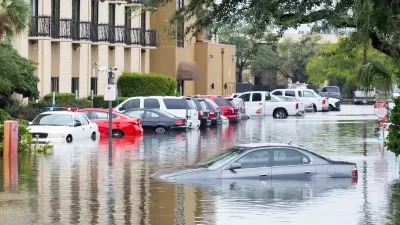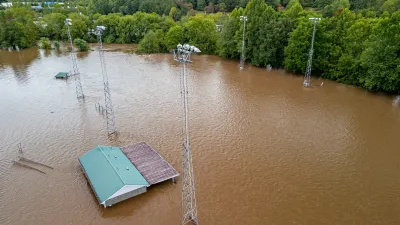Louisiana's chemical plants could release tons of toxic pollution into the air and water during storms, but anti-terrorism provisions make the process of finding risk management information prohibitively difficult.

A new analysis by New Orleans Public Radio (WWNO) and Southerly reveals high levels of risk for Louisiana communities located near the state's coastal chemical plants. The facilities, located in the path of annual hurricanes, emit more air pollution when they shut down in preparation for storms. If damaged by high wind or flooding, the plants run the risk of catastrophic pollution events that can expose wide swaths of the local community to toxic chemicals. The study used EPA data to identify the 30 facilities in the state that store the most toxic materials on site and analyzed the worst-case scenario for each. In ten cases, toxic gases could travel as far as 25 miles from the incident.
Information regarding risk management isn't always easy to come by in the post-9/11 era, with the chemical industry citing the potential for terrorist attacks as a reason to keep their plans closely guarded. To view industry risk management plans, residents have to make an appointment, view plans in person, and only take hand-written notes in the presence of a U.S. Marshal. A spokesperson for Shell, which owns four of the thirty plants in the analysis, would not discuss details but wrote in an email to WWNO that safety is a "top priority," adding that their operations follow strict federal, state, and local regulations.
But the secrecy can have an impact on local communities who can't easily assess the risks to their residents and first responders who lack the information to prepare for emergency scenarios. Emma Cheuse, an attorney with Earthjustice, calls the lack of information a "ticking time bomb" for coastal towns. Earthjustice is suing the EPA for rolling back Obama-era regulatory improvements and pushing for increased transparency and access to risk management information that can protect communities and help them prepare for future disasters.
FULL STORY: 'Ticking Time Bombs': Residents Kept In The Dark About Risks To La.'s Chemical Plants During Storms

Planetizen Federal Action Tracker
A weekly monitor of how Trump’s orders and actions are impacting planners and planning in America.

Chicago’s Ghost Rails
Just beneath the surface of the modern city lie the remnants of its expansive early 20th-century streetcar system.

San Antonio and Austin are Fusing Into one Massive Megaregion
The region spanning the two central Texas cities is growing fast, posing challenges for local infrastructure and water supplies.

Since Zion's Shuttles Went Electric “The Smog is Gone”
Visitors to Zion National Park can enjoy the canyon via the nation’s first fully electric park shuttle system.

Trump Distributing DOT Safety Funds at 1/10 Rate of Biden
Funds for Safe Streets and other transportation safety and equity programs are being held up by administrative reviews and conflicts with the Trump administration’s priorities.

German Cities Subsidize Taxis for Women Amid Wave of Violence
Free or low-cost taxi rides can help women navigate cities more safely, but critics say the programs don't address the root causes of violence against women.
Urban Design for Planners 1: Software Tools
This six-course series explores essential urban design concepts using open source software and equips planners with the tools they need to participate fully in the urban design process.
Planning for Universal Design
Learn the tools for implementing Universal Design in planning regulations.
planning NEXT
Appalachian Highlands Housing Partners
Mpact (founded as Rail~Volution)
City of Camden Redevelopment Agency
City of Astoria
City of Portland
City of Laramie





























